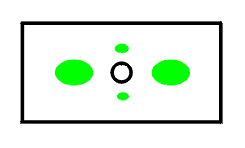I bought a set of 1x2x.5 neos with the 3/16" hole in them with plans to use the holes to locate and hold the magnets on the rotor. Since these are the first and only neo's I own, I have no basis for what is "normal"... I don't know whether there's a question here or not; it just seems weird:
When holding a screwdriver or other long, thin object loosely so that the end can be attracted to the magnet; I find it nearly impossible to get the end to rest on the center of magnet. It doesn't take much at all to "force" the tip of the screw driver to the center but if you let it move on its own, it will jump to one side or the other. I made the following picture in an attempt to show where the "neutral" points are where the tip of the screwdriver will stick (the areas in green)-

I can imagine that this magnet is topologically similar to a ring magnet; I did not expect the effect to be so profound.
I put a 1/2" long steel screw into the center wondering if somehow it wouldn't plug the magnetic hole there. On the side with the screw head, the screwdriver would attract to the screw head (where it sticks up over the surface of the magnet.) When moved slightly off the screw head, the tip of the screwdriver jumps to one of the regions shown in the picture. On the other side where the screw is flush with the magnet, there doesn't seem to be an difference whether the screw is in the hole or not. (The screwdriver tip won't go to the center, it goes to one of the regions shown in the drawing.)
As a ham radio operator (aa2mz) one thing I'd say when I saw a whacky radio antenna that appeared to work well was "well, radio waves have to go somewhere..." and I suppose that's true of flux, it has to go somewhere too. I wonder if a large amount of flux is going through the center hole and these magnets will be weaker for use in alternators or if the majority of the flux is just moved away from center hole and they will work about as good...
- Ed.